Races of the GalaxyIn a golden age some three thousand years in the past, the elder races of the galaxy ruled vast empires and had the command of advanced technologies that are now the stuff of legend. This age of prosperity and enlightenment was shattered by the many-sided conflict known as the Great War. Few records remain from that time, and it is not known whether any side claimed victory in the war, only that it ended with the collapse of the hyperspace lanes, the key to long-range interstellar travel. The elder races seemed to lose command of their supernal technologies, and weakened and isolated, their civilizations crumbled. The galaxy was plunged into a dark age, one from which it is only now reawakening. |
Ashdar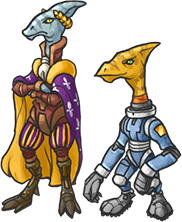
The Ashdar are a reptiloid race with two sub-species: the adventurous Teros and the taller, more somber Haduir. Today the Ashdar seem to be a convivial if ambitious people, but in the age before the Collapse, the Ashdar Empire conquered a large swath of the known galaxy and was a major participant in the Great War. The calamitous end to that war dissolved the Empire and scattered its remnants. Now two isolated fragments of the former Empire are attempting to rebuild, each believing itself to be the rightful heir to the Empire of old. Ashdar Colonials (Teros): Rastaban II, formerly a fleet base on the Imperial frontier, is now the capital of a growing colony populated primarily by the hardy Teros subspecies, who have thrived in the challenging environment. Led by an able Praetor, the colonials are eager to expand into the new frontier. Teros pilots, trained to fly in the treacherous Rastaban winds, are second to none. The mouldering starship hulks that still lie moored to the ancient fleet yards not only serve as a reminder of the glories of their ancestors, but also as useful examples to follow as the Ashdar seek to build a new fleet. Ashdar Imperials (Haduir): The ancient capital of Ashdar Prime, once a planet-wide megacity, now lies in ruins. Yet, a Haduir Emperor still sits on the throne, and holds court in the cavernous halls of the ruined Imperial palace. Though not as adaptable or adventurous as their Teros cousins, the Haduir have retained more knowledge of the old ways. The ancient archives, preserved deep within the crypts beneath the capital megacity, still keep some of the secrets from the elder world. Chief among these is the network of stargates, long-dormant, that allowed swift travel across the once-vast empire. As the great stargate begins to once again show signs of life, the ambitions of empire begin to stir within the inhabitants of the old capital. |
|
Yoral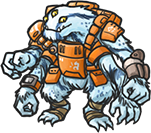
Arboreal creatures who turned to cave-dwelling to survive the environmental disaster that plunged their homeworld Verrold into a deep ice age, the Yoral are adept at using their survival skills to carve out self-sufficient colonies on worlds that most other races would dismiss as uninhabitable. The Yoral are organized into regional clans, answering to a central khagan. Blunt and direct, equally slow to forgive a slight or forget a favor, the Yoral conduct their affairs with a confidence and ferocity that belies their small size. They prefer technologies that are simple and reliable -- kinetic weapons over exotic energy beams, for example. Their fleets are rugged and often consist of large numbers of smaller vessels that can be replaced quickly and cheaply when the need arises. |
|
Gremak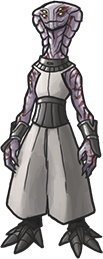
The Gremak evolved in the sweltering wetlands of the planet Gremal, and reproduce by laying large numbers of eggs and leaving them largely unattended to fend for themselves. Development through their various life stages to adulthood is long and treacherous, with many being killed or eaten (often by other Gremak) or enslaved. Those who do survive (through hard work, clever ingratiation, or absolute vicious cunning) eventually mature into the large, powerful adult Gremak, who are typically as courtly and diplomatic as they are ruthless and ambitious. The Gremak are ruled by a hereditary aristocracy, but their internal politics are dog-eat-dog... literally. Like the Ashdar, the Gremak were participants in the Great War that ended the ancient golden age, and suffered badly in its aftermath, the orbital bombardment of Gremal nearly exterminating all life there. Ever persistent, the Gremak have survived and rebuilt, and managed to retain a few of the technological secrets of their ancestors, including concealing distortion fields and powerful short-ranged energy torpedoes. In addition to the vessels of the Gremak Imperial Fleet, one may also encounter ships in the infamous red and yellow warpaint of the Marauders. These renegades exist on the fringes of the Gremak empire, raiding neighboring aliens for slaves and plunder. The Gremak imperial government maintains that the Marauders are an outlaw faction, but it is a poorly-kept secret that the destination for Marauder-taken slaves is often the estates of the Gremak aristocracy. |
|
Tinkers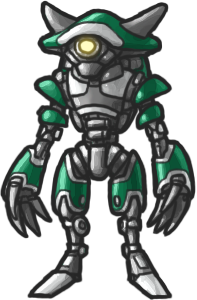
The Tinkers are a race of cyborgs who toil at the command of Dzibix, an ancient megamachine located on their arid homeworld of the same name. Dzibix is -- or was -- an automated factory built by one of the ancient civilizations of the Golden Age. But thanks to the efforts of the Tinkers, who worship Dzibix as some sort of machine god, it has grown to cover most of the planet and has achieved at least minimal self-awareness. However, its ancient directives are essentially the same: Work! Produce! Expand! And now these directives are treated as holy commands by the dutiful Tinkers, who have converted themselves into cyborgs and remade their society as a cybernetic civilization in the name of better serving their machine god. Tinkers prefer arid environments that do not interfere with the machinery of their bodies or that of their cities which sprawl across the landscape; water is an unwelcome obstacle to them. This intense industrialization ravages the environment of their colonies, but the Tinkers as cyborgs have reduced their need for food and the produce of nature. Having largely abandoned their natural life cycle, Tinkers reproduce slowly unless production is specifically allocated to this purpose. In harmony with their machine bodies and the orderly society it affords them, Tinkers do not know sadness or unrest; only duty. Tinkers worship their machine god through labor at Machine Altars, which are a specialized form of Factory that yields bonuses when staffed by cyborg workers. |

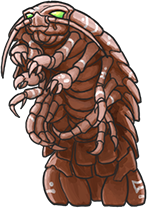 Orthin
Orthin
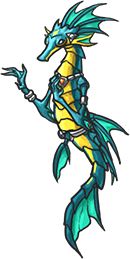 Phidi
Phidi
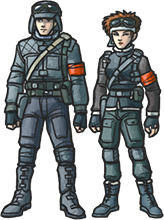 Humans
Humans